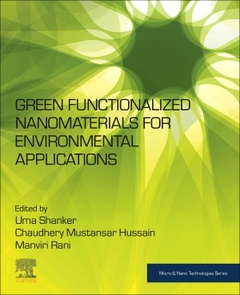Description
Green Functionalized Nanomaterials for Environmental Applications
Micro and Nano Technologies Series
Coordinators: Shanker Uma, Rani Manviri, Mustansar Hussain Chaudhery
Language: English
Subject for Green Functionalized Nanomaterials for Environmental...:
Keywords
Nanotechnology; Nanomaterials; Functionalized; Sustainable; Environmental; Green
622 p. · 19x23.4 cm · Paperback
Description
/li>Contents
/li>Biography
/li>Comment
/li>
Green nanomaterials are classed as nanomaterials with no environmentally harmful, toxic, properties. The photocatalysis of nanomaterials involves photo-conduction value in efficient removal/degradation of noxious pollutants. Green nanotechnology has objectives for the development of products and processes which are environmentally friendly, economically sustainable, safe, energy-efficient, and produce little waste or emissions. Such products and processes are based on renewable materials and/or have a low net impact on the environment. Green functionalized nanomaterials, formed by a combination of nanomaterials with natural materials or are derived through a green source, are the new trends in the remediation of pollutants in environmental industries. This has the effect of making photoactive nanomaterials work under UV/sunlight radiation in order to produce reactive radical species that rapidly remove pollutants by redox mechanism.
Green Functionalized Nanomaterials for Environmental Applications focuses on recent developments in the area of fabrication of green nanomaterials and their properties. It also looks at ways of lowering the risk of exposure of green functionalized nanomaterials. This needs to be pursued in the future for investigating and assessing health risks, which may be due to exposure to green nanomaterials. It is an important reference source for all those seeking to improve their understanding of how green functionalized nanomaterials are being used in a range of environmental applications, as well as considering potential toxicity implications.
1. Introduction to nanotechnology and green materials 2. Approaches for green innovations by nanotechnology 3. Green nanotechnology: Design and developments 4. Advanced green materials for industrial applications 5. Nanomaterials-based technologies in modern environmental industrial development 6. Sustainable manufacturing practices for potential development of green nanomaterials and technology 7. Modern applications and current status of green nanotechnology in environmental industry 8. Environmental impacts and life cycle analysis of green nanomaterials 9. Environmental, legal, health and safety issues of green nanomaterials 10. Guide paths to real-time utilization of green nanomaterials on a commercial scale 11. Green and sustainable future and conclusions
Manviri Rani is an expert in analytical method developments for various persistent organic pollutants. Her areas of research are analytical chemistry, environmental and green chemistry, persistent organic pollutants, plastic polymers and associated chemicals, chromatographic analysis, pesticide and polycyclic aromatic hydrocarbon analysis, solvent extraction, environment & health, and nanochemistry.
Chaudhery Mustansar Hussain is an adjunct professor and director of laboratories in the Department of Chemistry and Environmental Sciences at the New Jersey Institute of Technology (NJIT), Newark, New Jersey, United States. His research is focused on the applications of nanotechnology and advanced materials, environmental management, analytical chemistry, and other various industries.
- Highlights innovative industrial technologies for green functionalized nanomaterials
- Covers major fabrication techniques for sustainable functionalized nanomaterials
- Shows how sustainable functionalized nanomaterials are being developed for commercial applications
These books may interest you

Nanomaterials for Green Energy 177.10 €



